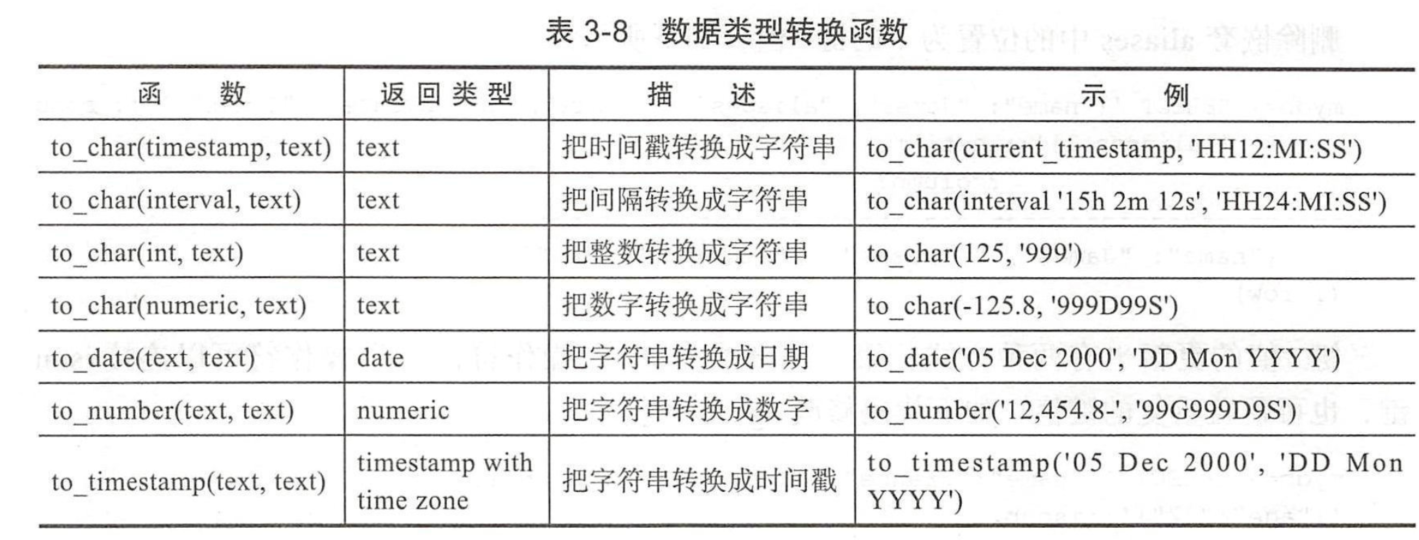参考《PostgreSQL实战》
3.1.2 数字类型操作符和数学函数
PostgreSQL 支持数字类型操作符和丰富的数学函数
例如支持加、减、乘、除、模取取余操作符
SELECT 1+2, 2*3, 4/2, 8%3;
按模取余
SELECT mod(8,3);
结果:2
四舍五入函数:
SELECT round(10.4) , round(10.5);
结果:10, 11
返回大于或等于给出参数的最小整数
SELECT ceil(3.6) , ceil(-3.6);
结果:4, -3
返回小于或等于给出参数的最小整数
floor(3.6) 结果:3
3.2.2 字符类型函数
PostgreSQL 支持丰富 的字符函数, 下面举例说明
计算字符串中的字符数
select char_length('abcd');
结果: 4
计算字符串占用的字节数
select octet_length('abcd');
结果: 4
指定字符在字符串中的位置(首次出现)
select position('a' in 'abcda')
结果: 1
select position('x' in 'abcda')
结果: 0
提取字符串中的子串
select substring('hello' from 3 for 4)
结果: llo
select substring('hello' from 4 for 1)
结果: l
拆分字符串
split_part (string text, delimiter text, field int )
根据 delimiter 分隔符拆分字符串 string,并返回指定字段,字段从 1 开始
select split_part('abc@def1@nb', '@', 1)
结果: abc
3.3.2 时间/日期类型操作符
时间 、 日期数据类型支持的操作符有加、减、乘、 除,
日期相加
select date '2017-07-29' + interval'1 days'
结果: 2017-07-30 00:00:00
日期相减
select date '2017-07-29' - interval'1 hour' 结果: 2017-07-28 23:00:00
日期相乘
select 100* interval '1 second'
结果: 00:01:40
日期相除
select interval '1 hour' / double precision '3'
结果: 00:20:00
3.3.3 时间/日期类型常用函数
显示当前时间
select current_date, current_time;
结果: 2019-11-23, 20:20:55.635115+08
另一个非常重要的函数为 EXTRACT 函数,可以从日期 、 时间数据类型中抽取年、月、日、 时、分、秒信息
EXTRACT(field FROM source)
field 值可以为 century、year、 month、 day、 hour 、 minute、 second等, source类型为 timestamp、 time、 interval的值的表达式。
取年份
select extract ( year from now())
结果: 2019
月份&月份里的第几天(当前时间2019-11-24)
select extract (month from now()), extract(day from now());
结果: 11, 24
抽取小时、分钟、秒语法同上,单词为hour,minute,second
抽取当前日期是所在年份的第几周&多少天
select extract(week from now()), extract(day from now())
结果: 47, 24
3.5.3 网络地址函数
PostgreSQL 网络地址类型支持一系列内置函数,下面举例说明。
取IP地址 , 返回文本格式。
select host(cidr '192.168.1.0/24');
结果: 192.168.1.0
取IP地址和网络掩码,返回文本格式
select text(cidr '192.168.1.0/24');
结果: 192.168.1.0/24
取网络地址子网掩码,返回文本格式
select netmask(cidr '192.168.1.0/24');
结果: 255.255.255.0
3.6.4 数据元素的追加、删除、更新
数组元素的追加使用array_append 函数
array_append(anyarray, anyelement)
array_append 函数向数组末端追加一个元素
select array_append(array[1,2,3], 4);
结果: {1,2,3,4}
数据元素追加到数组也可以使用操作符 ||
select array[1,2,3] || 4;
结果: {1,2,3,4}
数组元素的删除使用 array_remove 函数
array_remove(anyarray, anyelement)
array_remove 函数将移除数组中值等于给定值的所有数组元素
select array[1,2,2,3], array_remove(array[1,2,2,3], 2);
结果: {1,2,2,3}, {1,3}
数组元素修改:
update test_array_table set array_i[3] = 4 where id = 1;
UPDATE 1
更新整个数组
update test_array_table set array_i=array[7,8,9] where id = 1;
UPDATE 1
3.6.5 数组操作符

3.6.6 数组函数
数组维度
select array_ndims(array[1,2]);
结果: 1
数组长度(获取指定维度的长度)
select array_length(array[1,2], 1);
结果: 2
select array_length(array[[1],[2]], 2);
结果: 1
select array_length(array[[1],[2]], 1);
结果: 2
返回数组中某个数组元素第一次出现的位置
select array_position(array['a', 'b', 'c', 'd'], 'd');
结果: 4
数组元素替换可使用函数 array_replace
array replace(anyarray, anyelement, anyelement)
函数返回值类型为 anyarray,使用第二个 anyelement 替换数组中的相同数组元素
select array_replace( array[1,2,3,3,4], 3, 6);
结果: {1,2,6,6,4}
将数组元素输出到字符串,可以使用 array_to_string 函数
array_to_striiing( anyarray, text [, test])
函数返回值类型为text ,第一个text 参数指分隔符,第二个 text 表示将值为 NULL 的 元素使用这个字符串替换
select array_to_string(array[1,2,null,3], ',', '-1');
结果: 1,2,-1,3
还有array_to_json(array)函数,将数组直接转换为json
3.7.4 范围类型函数
以下列举范围类型常用函数
取范围下界
select lower(int4range(1,10));
结果: 1
取范围上界
select upper(int4range(1,10));
结果: 10
范围是否为空
select isempty(int4range(1,10));
结果: f
select isempty(int4range(10,10));
结果: t
3.8.5 jsonb与json函数
json 与 jsonb 相关的函数非常丰富, 下面举例说明
扩展最外层的 json 对象成为一组键/值结果集
select * from json_each('{"a":"foo", "b":"bar"}');
结果:
a | "foo"
b | "bar"
文本形式返回结果
select * from json_each_text('{"a":"foo", "b":"bar"}');
结果:
a | foo
b | bar
row_tojson()函数,能够将行作为json对象返回。
此函数常用来生成 json 测试数据,比如将一个普通表转换成 json 类型表
select * from test_copy where id = 1;
id | name
---+-----
1 | a
select row_to_json(test_copy) from test_copy where id = 1;
row_to_json
--------------
{"id":1,"name":"a"}
返回最外层的 json 对象中的键的集合
select * from json_object_keys('{"a":"foo", "b":"bar"}');
json_object_keys
---------------
a
b
3.8.6 jsonb 键/值的追加、删除、更新
jsonb 键/值追加可通过“||”操作符
select '{"name":"francs","age":"31"}' :: jsonb || '{"sex":"male"}' :: jsonb;
{"age": "31", "sex": "male", "name": "francs"}
jsonb 键 /值的删除有两种方法,一种是通过操作符 “-”删除,另一种通过操作符“#_”删除指定键/值
第一种
SELECT '{"name" : "James", "email": "james@localhost"}':: jsonb - 'email';
{"name": "James"}
select '["red","green","blue"]'::jsonb - 0;
["green", "blue"]
第二种 操作符“#_”删除指定键/值,通常用于有嵌套 json 数据删除的场 景
- 删除嵌套contact中的fax 键值
SELECT
'{"name":"James","contant":{"phone":"01234567890", "fax":"01923 342234"}}' :: jsonb
#-
'{contant,fax}' :: TEXT []
结果:
{"name": "James", "contant": {"phone": "01234567890"}}
- 删除嵌套contant中,坐标为0的键值
SELECT
'{"name":"James","contant":["first", "second", "third"]}' :: jsonb
#-
'{contant,0}' :: TEXT []
结果:
{"name": "James", "contant": ["second", "third"]}
键/值的更新也有两种方式
- 第一种方式为“||”操作符,“||”操作符可以连接 json键,也可以覆盖重复的键值
select '{"name":"AganRun", "age":"31"}'::jsonb || '{"age":"100"}' :: jsonb;
{"age": "100", "name": "AganRun"}
- 第二种方式是通过jsonb_set函数
jsonb_set(target jsonb, path text[], new_value jsonb[, create_missing boolean])
target 指源jsonb数据, path指路径, new_value 指更新后的键值, creat_missing 值为 true 表示如果键不存在则添加, create_missing 值为 false 表示如果键不存在则不添加
SELECT jsonb_set ('{"name":"francs","age":"31"}':: jsonb ,'{age}','"32"'::jsonb, false);
{"age": "32", "name": "francs"}
SELECT jsonb_set ('{"name":"francs","age":"31"}':: jsonb ,'{sex }','"male"':: jsonb, true);
{"age": "31", "sex": "male", "name": "francs"}
数据类型转换
格式化函数、CAST函数、操作符
3.9.1 通过格式化函数进行转换

3.9.2 通过 CAST 函数进行转换
varchar 字符类型转换成 text 类型
select cast(varchar'123' as test);
123
varchar 字符类型转换成 int4 类型
select cast(varchar'123' as text);
123
3.9.3 通过::操作符进行转换
例子转换成 int4 或 numeric 类型
select 1::int4, 3/2::numeric;
1 , 1.5
三种数据类型转换方法,第-种方法兼容性相对较好,第三种方法用法简捷
原文出处:https://www.cnblogs.com/AganRun/p/11924490.html
来源:oschina
链接:https://my.oschina.net/u/4257943/blog/3246353